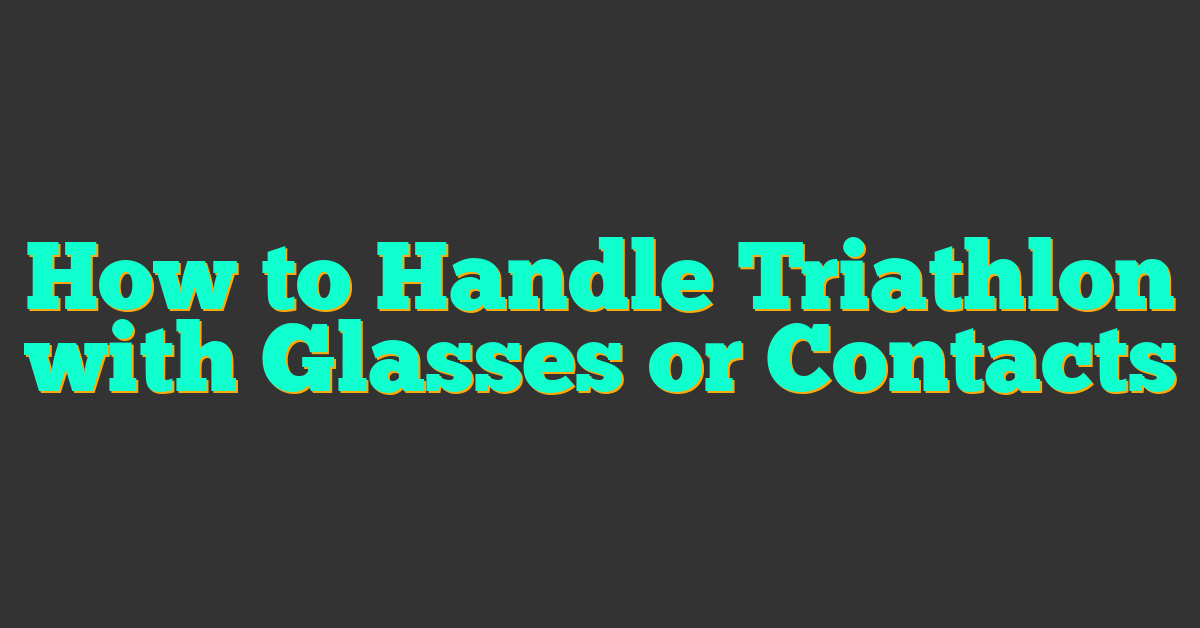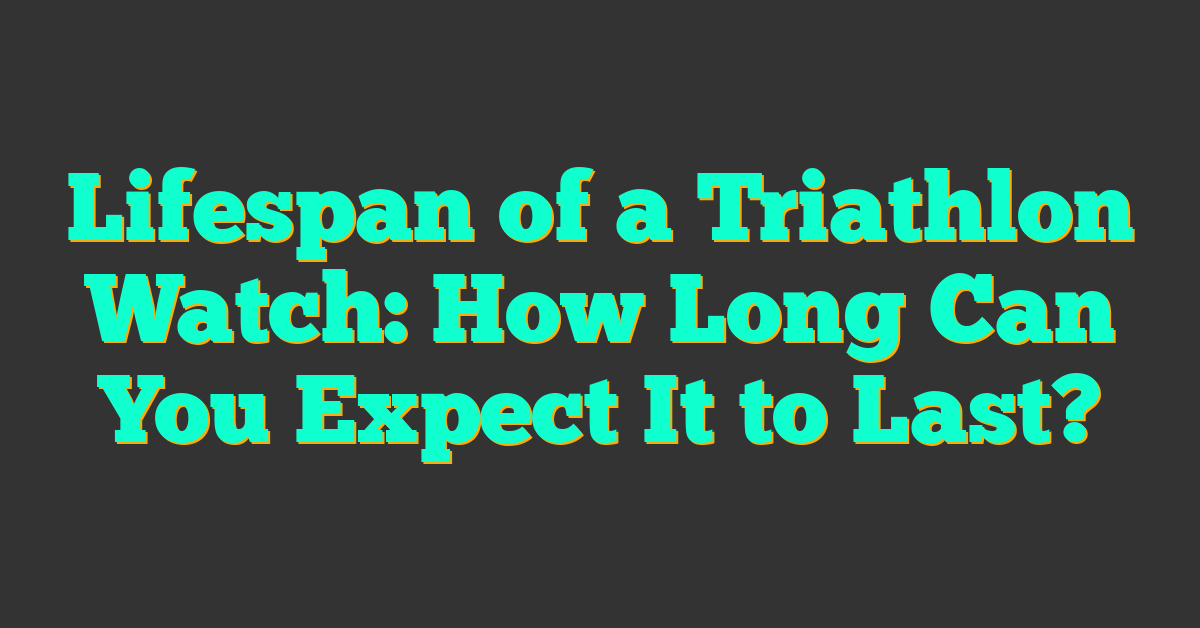If you wear glasses or contacts, participating in a triathlon can be a challenge. Not only do you have to worry about the physical demands of the race, but you also have to consider how to manage your vision needs throughout the event. However, with a little preparation and the right strategies, you can successfully navigate a triathlon with clear vision.

Before the race, it’s important to make sure you have the right gear. This includes a sturdy pair of sports glasses or contact lenses that are comfortable and secure. You’ll also want to consider bringing a backup pair of glasses or contacts, just in case something happens to your primary pair.
During the swim segment, it can be difficult to see clearly in the water. To maintain visual clarity, you may want to consider wearing goggles with prescription lenses or using anti-fog spray on your glasses. When transitioning to the bike segment, you’ll want to make sure your glasses or contacts are secure and won’t fall off during the ride. Finally, during the run segment, it’s important to stay hydrated to prevent dry eyes and discomfort.
Key Takeaways
- Prepare with the right gear, including backup glasses or contacts.
- Use goggles with prescription lenses or anti-fog spray during the swim segment.
- Stay hydrated during the race to maintain optimal eyesight.
Preparing for the Triathlon with Vision Needs

When you wear glasses or contacts, participating in a triathlon can be a little more challenging. However, with the right eyewear and preparation, you can complete the race safely and comfortably. Here are some tips to help you prepare for the triathlon with vision needs.
Choosing the Right Eyewear for Each Segment
During the swim segment, you can wear prescription goggles to help you see clearly underwater. Prescription goggles are available in a variety of prescriptions, so you can choose the one that best suits your needs. If you prefer to wear contacts during the swim, make sure they are securely in place and won’t fall out during the race.
For the bike and run segments, you can wear prescription sunglasses or regular glasses with a strap to keep them in place. Prescription sunglasses are a great option if you want to protect your eyes from the sun and glare. If you prefer to wear contacts during the bike and run, make sure they are comfortable and won’t dry out during the race.
Understanding the Importance of Proper Fit
When choosing eyewear for the triathlon, it’s important to make sure they fit properly. Ill-fitting glasses or goggles can slip and slide during the race, which can be distracting and uncomfortable. Make sure your eyewear is snug but not too tight, and that it doesn’t put pressure on your nose or ears.
If you wear contacts, make sure they are the correct prescription and that they fit properly. Ill-fitting contacts can cause discomfort and may even fall out during the race. Make sure you bring a spare pair of contacts just in case.
In conclusion, with the right eyewear and preparation, you can complete a triathlon even if you wear glasses or contacts. Choose the right eyewear for each segment, and make sure your eyewear fits properly to ensure a safe and comfortable race.
Swim Segment: Navigating the Waters with Visual Clarity
https://www.youtube.com/watch?v=w7iIf192S4w&embed=true
If you wear glasses or contacts, the swim segment of a triathlon can be a bit challenging. But with the right gear and preparation, you can navigate the waters with visual clarity.
Selecting Swim Goggles for Pool and Open Water
Swim goggles are a must-have for any triathlete, especially if you wear glasses or contacts. When selecting swim goggles, there are a few key factors to consider:
- Fit: Look for goggles that fit snugly but comfortably around your eyes. If they’re too tight, they can cause discomfort and leave marks on your skin. If they’re too loose, they can leak water and compromise your vision.
- Lens Type: For open water swimming, consider goggles with polarized or mirrored lenses to reduce glare and improve visibility. For indoor pool swimming, clear or lightly tinted lenses are ideal.
- Prescription Goggles: If you have a strong prescription, consider getting custom prescription goggles. These can be pricey, but they offer the best visual clarity.
Managing Contacts During the Swim
If you prefer to wear contacts during the swim segment, there are a few things to keep in mind:
- Use Daily Disposables: Opt for daily disposable contacts, which you can wear once and then throw away. This eliminates the need for contact lens solution and reduces the risk of infection.
- Bring Extras: Pack a few extra pairs of contacts in case one falls out or gets damaged during the swim.
- Use Goggles: Wear swim goggles over your contacts to keep them in place and protect your eyes from chlorine or saltwater.
If you prefer not to wear contacts during the swim, consider getting prescription swim goggles or practicing swimming without visual aids. With a bit of preparation and the right gear, you can conquer the swim segment of your triathlon with confidence and visual clarity.
Bike Segment: Ensuring Clear Vision on the Ride
https://www.youtube.com/watch?v=yAk6WnbYdcU&embed=true
When it comes to cycling, clear vision is essential for safety and performance. As someone who wears glasses or contacts, you may wonder how to ensure clear vision during the bike segment of a triathlon. In this section, we’ll discuss the role of sunglasses in cycling and how to handle contact lenses on the bike.
The Role of Sunglasses in Cycling
Sunglasses are a crucial accessory for any cyclist, regardless of whether you wear prescription glasses or contacts. They protect your eyes from harmful UV rays, reduce glare, and shield your eyes from dirt, dust, and insects. When choosing sunglasses for cycling, look for a pair that fits snugly, has non-slip nose pads and temple tips, and provides adequate coverage.
If you wear prescription glasses, you may want to consider getting prescription sunglasses. These can be made with your exact prescription, ensuring that you have clear vision while cycling. Alternatively, you can wear clip-on sunglasses that attach to your regular glasses.
Handling Contact Lenses on the Bike
If you wear contact lenses, you may be concerned about them falling out or becoming dry during the bike segment of a triathlon. Here are some tips to help you handle contact lenses on the bike:
- Before the race, make sure your contacts are clean and moist. Use a saline solution to rinse them before inserting them into your eyes.
- Wear sunglasses to protect your eyes from wind and debris. This will also help prevent your contacts from drying out.
- Consider using eye drops to keep your eyes moist during the ride. Look for preservative-free drops that are safe for contact lens wearers.
- If you’re worried about your contacts falling out, consider wearing a strap or band that keeps your glasses securely on your face.
By following these tips, you can ensure clear vision during the bike segment of a triathlon, whether you wear glasses or contacts. Remember to prioritize safety and comfort, and enjoy the ride!
Run Segment: Maintaining Optimal Eyesight to the Finish Line
« How to Go to the Bathroom During a Triathlon: Tips and Tricks
How to Handle Triathlon Weather Conditions: Tips and Tricks to Stay Safe and Comfortable »
When it comes to running, maintaining good eyesight is crucial. Whether you wear glasses or contacts, you need to make sure that your eyes are comfortable and free from irritation. Here are some tips to help you maintain optimal eyesight during the run segment of your triathlon:
Comfortable Eyewear Choices for Running
Wearing the right eyewear can make all the difference when it comes to running comfortably. If you wear regular glasses, you may want to consider switching to sports glasses that are designed for running. These glasses are lightweight, durable, and designed to stay in place even when you’re running at a fast pace. They also come with features like anti-fog coating and UV protection to help you see clearly in all conditions.
If you wear contacts, you may want to consider switching to daily disposable lenses. These lenses are designed to be worn once and then thrown away, which means you don’t have to worry about cleaning them after your run. They’re also more comfortable than traditional lenses, which can be a big plus when you’re running long distances.
Dealing with Sweat and Irritation
When you’re running, sweat and irritation can be a big problem for your eyes. To avoid this, make sure you’re wearing eyewear that fits properly and doesn’t move around too much. You should also consider using a sweatband or headband to keep sweat from dripping into your eyes.
If you wear glasses, you may want to consider using a strap to keep them in place. This will help prevent them from slipping down your nose when you’re sweating. You can also use anti-fog wipes or sprays to keep your glasses from fogging up during your run.
If you wear contacts, you may want to consider using lubricating eye drops to help prevent irritation. These drops can help keep your eyes moist and comfortable, even when you’re sweating heavily.
By following these tips, you can maintain optimal eyesight during the run segment of your triathlon. Whether you wear glasses or contacts, there are plenty of ways to stay comfortable and avoid irritation while you’re running.
Transition Strategies and Post-Race Care
Mastering Quick Changes at T1 and T2
Transition time is crucial during a triathlon. You want to make sure you don’t waste time fumbling around with your glasses or contacts. Here are some strategies to help you master quick changes during T1 and T2:
- Practice, practice, practice: Practice taking off and putting on your glasses or contacts during your training sessions. This will help you get used to the process and make it quicker and smoother during the race.
- Keep your glasses or contacts within reach: Make sure your glasses or contacts are within reach as soon as you enter the transition area. You don’t want to waste time looking for them.
- Use a transition mat: Use a transition mat to keep your glasses or contacts clean and safe. This will also help you find them quickly.
- Use daily disposable lenses: If you wear contacts, consider using daily disposable lenses. This will eliminate the need for cleaning and maintenance, and you can simply throw them away after the race.
Eye Care After the Triathlon
After the race, it’s important to take care of your eyes to prevent infections, dry eyes, and discomfort. Here are some tips to help you take care of your eyes after the triathlon:
- Clean your glasses or contacts: Clean your glasses or contacts thoroughly to remove any dirt or sweat. Use a lens cleaning solution and a microfiber cloth to avoid scratching the lenses.
- Use lubricating eye drops: If you have dry eyes after the race, use lubricating eye drops to moisten your eyes. This will help relieve discomfort and prevent infections.
- Rest your eyes: Rest your eyes after the race by closing them for a few minutes or taking a nap. This will help reduce eye strain and fatigue.
- Consult an eye doctor: If you experience any eye problems after the race, such as redness, irritation, or vision changes, consult an eye doctor immediately.
By following these strategies and taking care of your eyes after the race, you can ensure that your eyes remain healthy and comfortable during and after the triathlon.
Frequently Asked Questions
https://www.youtube.com/watch?v=13Bjb2dsPxk&embed=true
What are the best options for prescription swim goggles during a triathlon?
If you’re a triathlete who wears prescription glasses or contacts, you may want to consider using prescription swim goggles. These goggles are designed to help you see clearly underwater and come in a variety of prescription strengths. Some popular brands include Aqua Sphere, Speedo, and TYR. Make sure to try on different brands and models to find the one that fits you best.
Is it safe to swim with contact lenses in a triathlon?
While it is possible to swim with contact lenses, it is not recommended. Contact lenses can become dislodged or damaged during the swim, which can cause irritation or even eye infections. If you do choose to wear contact lenses during a triathlon, make sure to use daily disposable lenses and bring extras to change into during transitions.
Should I opt for glasses or contact lenses for the cycling and running segments of a triathlon?
The choice between glasses and contact lenses ultimately depends on your personal preference. Glasses can be more comfortable and provide better protection from the wind and sun, while contact lenses offer a wider field of vision and are less likely to fog up. Consider trying both options during your training to see which one works best for you.
How do triathletes manage their vision correction during transitions?
During transitions, triathletes typically leave their glasses or contacts in a designated area and put them on or change into them after the swim or bike segment. Make sure to practice your transitions beforehand to ensure a smooth and quick process.
What are the pros and cons of using daily disposable contacts for a triathlon?
Daily disposable contacts can be a good option for triathletes who prefer to wear contacts during the race. They eliminate the need for cleaning and storage, and reduce the risk of eye infections. However, they can be more expensive than traditional contacts, and you will need to bring extras to change into during transitions.
Are there any specific strategies for handling glasses during a triathlon?
If you choose to wear glasses during the race, consider using a strap to keep them securely in place. You can also use a towel or cloth to wipe them down during transitions to prevent fogging or smudging. Make sure to practice handling your glasses during training to ensure a smooth and quick transition.













